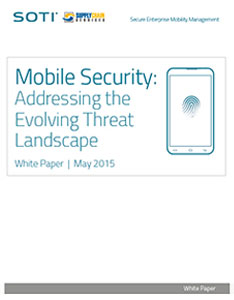Mobile Security: Addressing the Evolving Threat
As mobile is intrinsically woven into the fabric of enterprise, mobile security is less about protecting data and devices and more about protecting intellectual property, brand value, and customer trust.
Mobile computing continues to expand throughout organizations to increase efficiency, empower collaboration, speed workflow, and boost employee productivity.
The expansion of enterprise mobility across many organizations is having a transformative effect to their business and fueling product and service differentiation.
Mobility is no longer a “must-have” in the employee toolkit; it is as ubiquitous as a desktop computer.
Once relegated to line of business and management use, mobility use continues to expand throughout many organizations as business units discover novel applications to drive their businesses forward.
In many aspects, the rise of mobile devices, from smartphones, tablets, to smart peripherals and smart connected devices, is the most significant change to business workflow since the invention of the personal computer.
Mobility is ‘computing’, as mobile devices have evolved from what we referred to as ‘smartphones’ to a powerful computer in everyone’s pocket, where the phone is just another app.
With this evolution toward a mobilized enterprise, CIOs and IT organizations must ensure corporate security policies can accommodate the expansive mobile ecosystem – from form factors, to capabilities, operating systems, applications and communications protocols.
As mobile is intrinsically woven into the fabric of enterprise, mobile security is less about protecting data and devices and more about protecting intellectual property, brand value, and customer trust. IT is tasked with a continual assessment of the changing threat landscape to ensure users are aware of risks and policies are created to mitigate those risks.
The purpose of this white paper is to consider a holistic approach to mobile security that includes enterprise mobility management (EMM), and discusses best practices for securing mobility without diminishing the potential for mobile utility.
What’s Related



Favorites





